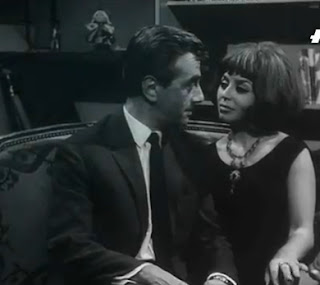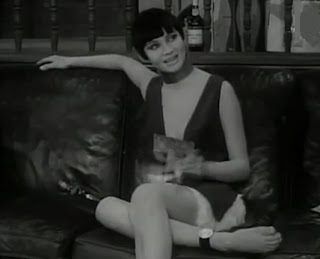After examining Polish 60's Beat/Garage/Psyche scene in my last post, now I would like to focus on depictions of 1960's youth in Polish cinema of the time. Using stills from various films, I want to show some surprisingly cool looks and talk about a few fashion/screen icons of that time.
If you're a 1960's cinema aficionado, you may know that just like Britain had its 'Kitchen Sink' movement and France had Nouvelle Vague, Poland had so-called Polish Film School movement - named after Film Academy in Lodz, the alumni of which included Roman Polanski, Andrzej Wajda, Jerzy Skolimowski or Jerzy Kawalerowicz. Some of them left Poland for political reasons - like Roman Polanski who left in 1962 after his debut full-length feature, Knife In The Water, was criticised heavily by Polish authorities (despite being a first Polish film nominated for Academy Award). Jerzy Skolimowski left in 1967, after his film Rece Do Gory! (Hands Up!) - a surrealistic attack on political ruling class - was banned and shelved. Poland's loss became America's gain - certainly as far as Roman Polanski is concerned. By the late 1960's , he became one of the Hollywood's brightest stars, and despite the series of tragedies and scandals he continues to be a successful filmmaker to this day. Skolimowski, after an unsuccessful attempt at career in Hollywood, settled in Britain where he made some great films like Deep End (1970) or Shout!(1978). But most of Polish Film School directors decided to stay in the country, and fight for their right to be Polish artists in Poland - like Andrzej Wajda - four time Oscar nominee - who was arguably the greatest Polish director of all time.
However, I don't really want to talk about cinema as such. Here, I am merely using it to depict popular styles, fashions, etc. Most of the films I am using here are quite obscure even in Poland,and certainly not all of them are particularly important as cinematic pieces of art. Some of them are really good, some are dead-on average. To my knowledge, none of them was ever distributed in English-speaking countries, or perhaps even anywhere outside Poland. In any case, they do contain little scenes in which you can some great 1960's styles.
Still from a comedy titled Malzenstwo Z Rozsadku (Sensible Marriage) from 1966. Polish Mod girl who wouldn't look out of place on Carnaby Street. Not sure about the guy, though. He looks quite out of place even on the streets of Warsaw.
Few stills from a film Beata (It's a name, Polish for Betty) from 1964
The film is a story of Beata - rebellious teenage girl who tries to fight the hypocrisy of her parents and teachers. When her best friend becomes pregnant after one-night stand, and subsequently expelled from school, Beata runs away from home, partly as a form of protest, partly intending to find a guy who got her friend in trouble,and partly to annoy her own bickering parents and conservative teachers.
It was probably one of the first Polish films to deal with a subject of ten pregnancy or teenage rebellion.
The role of Beata is played by Pola Raksa, who was one of the most popular Polish actresses of 1960's. She is also generally thought to be the most beautiful Polish actress of all-time. Despite having very successful career in the 1960's, she decided to quit acting as the decade came to an end, to focus on a new career as a fashion designer.
Few stills from the film Rozwodow Nie Bedzie ( There Isn't Gonna Be A Divorce) from 1963.
Few stills from the film Rozwodow Nie Bedzie ( There Isn't Gonna Be A Divorce) from 1963.
It's a story of three young couples and their lives shortly before, and right after their weddings.
That slightly androgynous-looking brunette above is a model-turned-actress named Teresa Tuszynska. She came to considerable fame after starring in cult Polish Film School movie Do Widzenia, Do Jutra (Goodbye, See You Tomorrow) in 1960.
Few stills from great Gothic thriller Gdzie Jest Trzeci Krol? (Where Is The Third King?) from 1963.
This often overlooked Polish Film School movie was clearly inspired by French New Wave - It resembles early 1960's films of Jean-Luc Godard, although it's way more coherent.
Few stills from great Gothic thriller Gdzie Jest Trzeci Krol? (Where Is The Third King?) from 1963.
It is a great story of the mysterious deaths and robberies in a secluded countryside museum.
Few scenes from 1965 film Sam Posrod Miasta (Alone In The City)
It's story of an engineer, who is about to go for a two-year work placement abroad. He misses his plane and has to wait 24 hours for next one. He already gave up his flat, so for a day and night he wanders around streets of Warsaw, reminiscing about his life there, bumping into mates, drinking and smoking in jazz clubs and having random conversations with strangers.
In one scene, the young girl which main character is trying to pull, takes him to a Mod/Beat club full of sharp-suited boys and girls in minis with bobs.
In 1965, the influence of Mod subculture on fashion was so enormous, it made its way behind iron curtain.
Stills from the film Lekarstwo Na Milosc (The Cure For Love) from 1965
Stills from the film Lekarstwo Na Milosc (The Cure For Love) from 1965
It's a comedy about a robbery gone wrong, with a romantic subplot. The actress with impressive hairdo was a famous sex symbol and fashion icon in Poland in 1960's. Her name was Kalina Jedrusik. She was known for her voluptuous shapes and her flair for femme fatale - type roles.
The guy in the photo below was probably the most famous Polish actor, not only of the 1960's, but possibly of all time. His name was Zbigniew Cybulski. Known as 'Polish James Dean' he was a male symbol of cool. His role in most famous Polish Film School movie - Andrzej Wajda's Ashes and Diamonds (1958), elevated him to the status of a star.In that film his character - Warsaw Uprising veteran - wore sunglasses to protect his eyes from the sunlight after months spent fighting in underground sewers. But the sunglasses became such a trademark of Cybulski, that he subsequently wore them for the rest of his career (occasionally exchanging them for normal glasses, like he did in Alone In The City).Cybulski died in a freak accident while trying jumping on the riding train in 1967. His death assured his cult status in Poland furthering the parallels with James Dean. Unlike Dean, Cybulski was a very prolific actor, starring in over 40 movies in just several years.
This still of him with his trademark quiff + sunglasses + cigarette look comes from short art house production titled Iluzja (Illusion) from 1966. It is a study of behaviour of various young people in smoky jazz club.
I'll end with a rare Polish attempt at science fiction genre.It is a 1968 film directed by great Andrzej Wajda titled Przekladaniec. I'm not sure whether this word has English equivalent. In Wajda's English Wikipedia entry this film is listed as Roly-Poly, which doesn't seem accurate.. In any case, This 35-minute curio is a story of a racing driver who, after a series of accidents undergoes so many transplants, that he starts losing a sense of his own identity. Not really science fiction as such, more like futuristic nightmare. The film was based on a short story written by famous Polish philosopher/sci-fi writer Stanislaw Lem, who was known for such nightmarish and dystopian visions of the future. The film was shot in New York, but with Polish cast.
The costumes were clearly inspired by Space-Age designs of Pierre Cardin and Andre Courreges. They were made by state-funded Polish couture house called Hoff.
One of the scenes features a bunch of dodgy hippies trying to flog their own organs outside transplant clinic.
This guy with two pairs of painted-on eyes looks pretty creepy. I must try it one day just to see the look on people's faces...
Famous Polish ballet dancer Gerard Wilk in cameo role of a sinister insurance agent.
Poster for Andrej Wajda's film Polowanie Na Muchy (Hunting Flies) from 1969.
I am gonna finish my two-post 'Polish Special' here.... The sixties in Poland were not a particularly happy period, which may account for the fact that apparently 'Retro' as a phenomenon never really caught on there among young people. Which is a shame because that era - as grim as it was - produced some great music, films, and culture in general which does not deserve to be forgotten.












































4 comments:
This is such a great post, I've really enjoyed learning about what the 60s was like in Poland. Thanks for posting.
Google Translate translates przekładaniec as layer cake. So a bit like (jam) roly-poly.
Hi!
These three young people above with a paint and flowers on their faces (f.e. the guy with multiple eyes) are the members of the rock band (by then in a psychedelic style) Niebiesko-Czarni (The Blue-Blacks), from the top: Wiesław Żakowicz - sax, Ada Rusowicz - voc and Krzysztof Potocki- bass. The whole band appeared for a short while in this movie as human body parts dealers.
Never quit this blog. Just seriously please never stop doing this. I was born in 1968 but have a crazy photographic memory: I remember all of these hairstyles and fashions, and I am in HEAVEN...
Post a Comment